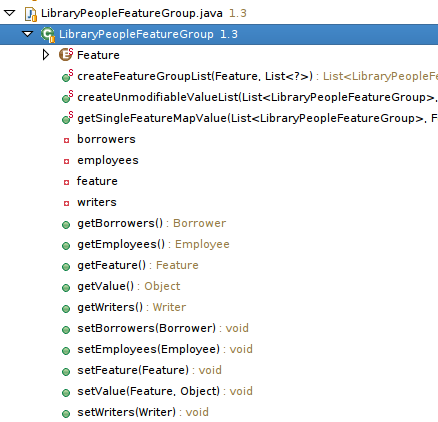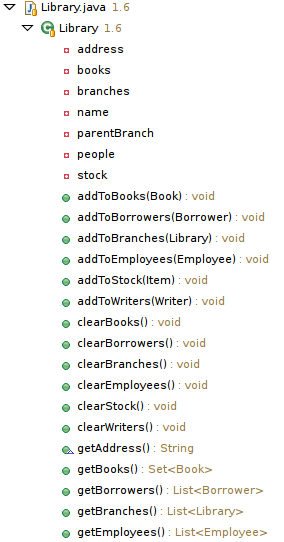Notice: this Wiki will be going read only early in 2024 and edits will no longer be possible. Please see: https://gitlab.eclipse.org/eclipsefdn/helpdesk/-/wikis/Wiki-shutdown-plan for the plan.
Texo/Code Generation Patterns
Contents
Introduction
The code generation of Texo can be controlled in detail using annotations. This document describes some possible code generation patterns which can be implemented using annotations. In addition this document describes some other specific code generation patterns implemented by Texo.
Let a non-generated class be used for an EClass
Say that you already have a class which implements an EClass, the java class has getters and setters for the EStructuralFeatures of the EClass. Texo makes it possible to use this custom java class in place of the generated class. So Texo won't generate an entity class but will instead use the custom java class. This means that references to the EClass are generated as references to the custom java class.
For example say you have a model with two EClasses: Car and Owner and there is an EReference Car.owner which references the Owner EClass. Then if the Owner is represented by a custom java class: CustomOwner, Texo will make sure that the getter, setter and java member for Car.owner refers to the CustomOwner class.
To tell Texo to use the custom java class for an EClass, the following has to be done:
- specify a Model Gen Annotation on the EClass, see here for information on how to this.
- set the 'Generate Code' property to false, this makes sure that Texo won't generate an entity class for this EClass
- set the 'Qualified Class Name' property to the fully qualified of the custom java class
Handling Feature Maps
EMF uses feature maps for flexible structures present in XML Schema (for example the xsd:choice). For more information on EMF feature maps see the following links:
Texo fully supports the EMF feature map by generating a separate class for a feature map element. The feature map itself then becomes a List which contains the generated feature map entry class.
See this example model, the Library EClass has a feature map people. The people feature is a list of three different types: Writers, Employees, Borrowers. Java can't support a List/Set of different types (other than the very type-unsafe and unexpressive List<Object>). Teneo solves this differently it creates a separate class for the element in the feature map list, in this example a LibraryPeopleFeatureGroup class is generated. This class has several utility methods and methods to set/get a writer, borrower or employees.
The advantage of creating a separate class to represent the feature map element is that it fairly straight forward to map this class to a database using an ORM or to other external tools while still maintaining an expressive api.
Generation of a save bi-directional association API (or not)
Texo can generate two types of api's for many EReferences (EReferences which can hold multiple values):
- a normal getter/setter:
public void setBooks(List<Book> newBooks); public List<Book> getBooks();
- an extended api:
public void setBooks(List<Book> newBooks); public List<Book> getBooks(); // returns an unmodifiable list public void addToBooks(Book book); public void removeFromBooks(Book book);
The first api is simple to use but in case of a bi-directional association a programmer has to explicitly set both sides of the association.
The second api is a bit more complex but Texo internally takes care of handling bi-directional associations. So the developer only needs to set one side of the association, Texo automatically sets the other side.
To tell Texo which type of api to create there is the 'Generate save many access' property on the EPackage Model Gen annotation. Set it to true to generate the more extensive (but safer) api, or to false to get the more simple api.
Use List or Set for an isMany EStructuralFeature
Texo makes it possible to choose between java.util.List or java.util.Set when generating code for an isMany EStructuralFeature. Texo uses two control parameters:
- if there is a Model Gen annotation on the EStructuralFeature and its property useList is set, then that is used to choose between List or Set
- the ordered feature of the EStructuralFeature is checked, if ordered==false then a Set is used, otherwise java.util.List is used.
Only Generate Entities - No EMF dependencies
As a default Texo will generate 2 classes: ModelPackage and ModelFactory, which have dependencies on EMF. These two classes are needed for the following runtime functionality:
If this functionality is not important for your specific case and you want to prevent any compile time dependency on EMF you can direct Texo to not generate the 2 Model* classes. Do this by setting the 'Add model runtime behavior' property of the EPackage Model Gen annotation to false.


